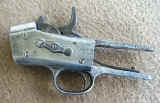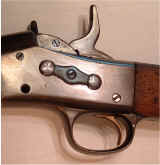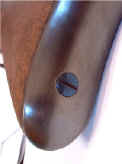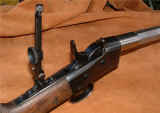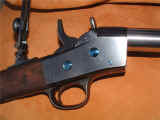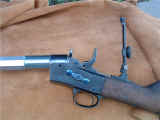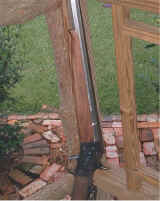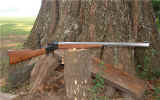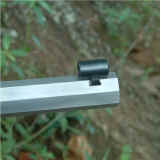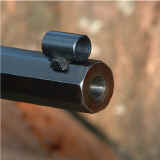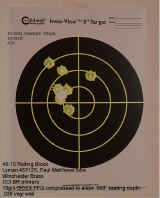Remington Rolling Block
An original Model 1869 in .43
Spanish
(11.15 x 58R mm)
The gun was a rusted battered wreck. It had been abused and neglected for years. The forend was gone, the bore looked like the inside of a sewer pipe. It looked like junk.
I soaked it for a few weeks and then cleaned the rust off the best I could. I pulled the barrel and dis-assembled the receiver and cleaned it inside and out and figured, "We can save this one."
Then I purchased a new barrel blank from Adams & Bennett. The sights were purchased from Taylor & Co. and eventually the whole thing was given to friend John Killebrew. John is an engineer who works for a large company and "tinkers" with guns in his spare time.
I did not realize he was going to go to such trouble and refinish the gun as much as he did! He tig welded the cracks, filled in the bad places, polished and sanded it until the old gun came to life again. He was on his way to attempting to restore the old gun to its former glory when I told him, "John .. it's just a shooter!" (I found out what he was doing when he called and almost apologetically said he just could not get rid of all the rough spots. I was surprised .. but should have known. John is a perfectionist.)
I had John chamber the barrel in .45-70 Government. He fitted it to the action, headspaced it and installed the sights. He also brought the battered stock back to life and then made a replacement forend that matched it really well!
I think you will agree that John is really an artist!
A Short and Improper
History
(with
apologies to the places I stole it from)
Leonard Geiger who worked for Remington Firearms, patented a single-shot, breech loading mechanism for use with metallic cartridges in 1863. Geiger's design was modified by Joseph Rider, Remington's Plant Supervisor in 1864. Further improvements of the design in 1865 and 1866 culminated in the Remington-Rider rolling block action.
The Remington rolling block quickly became known as one of the strongest and most reliable actions of the era. While the US military contracts were small, foreign contracts from dozens of countries poured in. Remington produced more than one and a half million rifles by the beginning of the 20th century. The development of repeating arms drastically reduced the military usefulness of the Rolling Block but these rifles were still being used by major powers through WWI and by smaller nations long after that.
Design changes were quick to follow the production of the Rolling Block. The Model 1871 U.S. Army Rolling Block Rifle - caliber 50-70 Govt - incorporated an action with a half-cock safety. In the Model 1869, when the breechblock is closed the action is at full cock and ready to fire. In the Model 1871, when the breechblock is closed the hammer automatically drops to half-cock. In order to fire the hammer must then be re-cocked. This was done as a safety feature. The Model 1869 can "slam-fire" upon closing the breech if the firing pin is stuck in the forward position (due to dirt, damage or some other reason) and the breech is rapidly slammed shut. If a slam-fire occurs with the hammer at full cock the breech is not locked. This can be disastrous for the shooter. The Model 1871 design made sure the breech was locked. Other countries incorporated various improvements to keep a "slam-fire" from happening.
The Remington Rolling Block was without a doubt the world's most accurate rifle of the time. This was clearly demonstrated during the international rifle matches of 1874.
It has been chambered in a number of calibers from the .22 rim fire to .58 caliber.
The Rolling Block design was in production for seventy years (not counting the modern-made ones). It was manufactured in various countries at different times. Estimates of production of the rolling block action go as high as 70 million firearms.
